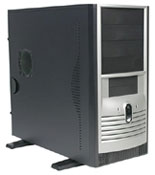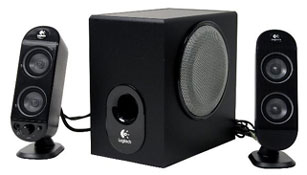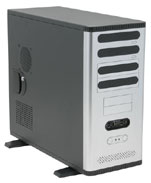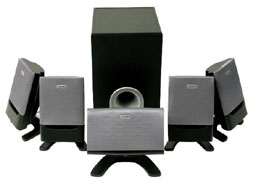Entry Level Buyer's Guide, October 2005
by Jarred Walton on October 14, 2005 12:05 AM EST- Posted in
- Guides
Miscellaneous Part Recommendations
We've covered the major components for a computer, and we'll finish by covering the storage, keyboard, mouse, sound, networking, case, and power supply choices. (That's a lot of choices left, but the impact on performance for most of them is negligible at best.) If you grab the cheapest parts for several of these options - input devices and speakers - then you can get the bare minimum of functionality. Depending on how much you plan on using the computer, though, we'd upgrade some options.
First, the keyboard and mice are how you actually communicate with the computer (unless you're planning on trying out some voice recognition software). If you're going to be using the computer for work, sitting at it eight hours a day, then do your body a favor and get a keyboard and mouse that are comfortable for long-term use. Ergonomic keyboards might help a bit if you have carpal tunnel problems or suffer from RSI (Repetitive Stress Injury). Of course, the truth is that the best way to combat such problems lies elsewhere: a good desk and chair combined with frequent breaks is critical for long-term comfort. The desk and chair can easily cost more than an entire computer; thankfully, upgrades are rare occurrences. We've given you a bit of advice on what you might want to consider, but the rest is up to you. As usual, we're going to recommend a standard keyboard/mouse combo from either Logitech or Microsoft.
Sound and networking devices are really easy to cover: use the integrated devices on the motherboard. Every modern motherboard includes both sound and network functionality. Is it the best sound that you'll ever hear from a PC? Hardly, but you probably won't care much. Networking performance is even less critical; unless you're planning on running gigabit Ethernet wiring, nearly all 10/100 network devices are close enough in performance that discussing it further amounts to splitting hairs.
For the speakers, at least for non-gaming use, just grab a $10 to $20 set (or use what you already have). If you need a truly cheap recommendation, you can get a pair of Logitech S-100 speakers for free with the purchase of a keyboard, courtesy of Newegg. It's tough to beat free (though we're really only saving $7). The sound quality just about matches the price, so if you want something where you could actually listen to a CD or even watch a DVD on your computer, you'll want to bite the bullet and at least get some speakers with a subwoofer. Small satellites simply can't produce bass well, and cheap satellites are even worse. Logitech's X-230 speakers run $37 shipped and provide a good minimum level of sound quality. We'll use those for the home/office setup, but for gaming, we'll upgrade to 5.1 speakers.
Office Components:
Gaming Components:
Most of the choices should be pretty self-explanatory, so we just want to touch on the important areas. First, our hard drive and optical drive selections are essentially a toss up. Our last Hard Drive Roundup showed that SATA 3.0Gbps drives were faster in some areas, and NCQ could help out in certain tests as well, but there was no clear victor. This is a budget guide, so price as well as $/GB are going to be the primary factors in what we select. Hitachi won out in both the 80GB and 160GB categories - we chose a larger drive for the gaming system, though in truth, you could put either drive in either configuration, depending on how you plan to use the PC. The less than 40 cents per GB cost of some Maxtor 250GB models also bears mention, but we aren't big fans of the MaxLine II models and wanted to keep the HDD cost under $100, so we didn't upgrade to a 200GB or larger drive. The 160GB choice will still provide plenty of room for games, videos, music, photos, and whatever else you might want. Combined with the ability to archive old data to DVDR discs, storage capacity shouldn't be a major concern.
The 5-year Seagate warranty (you can get a similar warranty on the more expensive Western Digital drives) is also something to consider, but warranties don't cover lost data. (You might want to wait for the new Seagate drives as well, if you're looking to get a Seagate anyway.) That's why a good backup strategy is important, and the DVDR drives provide that. Firmware updates to the NEC 3540A, BenQ DW1640, and Pioneer 110D drives have ironed out most of the media compatibility issues, so they pretty much tie for price, performance, and compatibility. NEC wins on total cost plus shipping right now, but prices can fluctuate daily, so feel free to choose one of the other models.
The case and power supply choices are certain to draw plenty of comments, as they did with the last budget guide. We actually picked up the MGE CAG-M1-BK with the 400W PSU that we listed to run it through some tests. The quick summary is that the case is flimsy and cheap, the front panel connectors feature individual connections for the USB and Firewire ports rather than a nice molded block, and as a whole, the case is underwhelming. For $65 shipped, though, it gets the job done. It's been running almost 24/7 for a couple of months without any problems, even when overclocking a Sempron to 2.60 GHz. Will the power supply fail at some point? Probably. With the overclocked Sempron and an X800 Pro, though, peak power draw is only hitting 190W or so. For a budget system, you really don't need to go out and buy a $75 PSU in order to run stable. Something else to consider is that since shipping costs about $15 for many cases when ordered online, you might just run down to your local computer shops to see what's available.
The Foxconn cases and power supplies that we chose for this month's gaming selections are of higher quality than the MGE, but they're still not high-end. The "office" selection is a bit cheaper and only includes a 300W PSU (which should be fine for the integrated graphics and other components). For the gaming case, the PSU has a 24-pin power connector (really, this time!), and it's also ATX2.0 compliant. Both have a relatively conservative look, and we like the more expensive model a bit more. It has spring-loaded optical drive doors on the top two 5.25" bays. The cases also include a 120mm fan mounted at the back and a CPU duct, which should easily handle our budget builds.
You may eventually need to upgrade the case a bit with a new PSU or a second fan, but with Intel's talk of performance per Watt, the next generation PCs may actually reduce power requirements. (Here's hoping...) We don't expect people to have problems with either of these cases, but if you start thinking about adding multiple hard drives, you might need a heftier PSU.
We've covered the major components for a computer, and we'll finish by covering the storage, keyboard, mouse, sound, networking, case, and power supply choices. (That's a lot of choices left, but the impact on performance for most of them is negligible at best.) If you grab the cheapest parts for several of these options - input devices and speakers - then you can get the bare minimum of functionality. Depending on how much you plan on using the computer, though, we'd upgrade some options.
First, the keyboard and mice are how you actually communicate with the computer (unless you're planning on trying out some voice recognition software). If you're going to be using the computer for work, sitting at it eight hours a day, then do your body a favor and get a keyboard and mouse that are comfortable for long-term use. Ergonomic keyboards might help a bit if you have carpal tunnel problems or suffer from RSI (Repetitive Stress Injury). Of course, the truth is that the best way to combat such problems lies elsewhere: a good desk and chair combined with frequent breaks is critical for long-term comfort. The desk and chair can easily cost more than an entire computer; thankfully, upgrades are rare occurrences. We've given you a bit of advice on what you might want to consider, but the rest is up to you. As usual, we're going to recommend a standard keyboard/mouse combo from either Logitech or Microsoft.
Sound and networking devices are really easy to cover: use the integrated devices on the motherboard. Every modern motherboard includes both sound and network functionality. Is it the best sound that you'll ever hear from a PC? Hardly, but you probably won't care much. Networking performance is even less critical; unless you're planning on running gigabit Ethernet wiring, nearly all 10/100 network devices are close enough in performance that discussing it further amounts to splitting hairs.
For the speakers, at least for non-gaming use, just grab a $10 to $20 set (or use what you already have). If you need a truly cheap recommendation, you can get a pair of Logitech S-100 speakers for free with the purchase of a keyboard, courtesy of Newegg. It's tough to beat free (though we're really only saving $7). The sound quality just about matches the price, so if you want something where you could actually listen to a CD or even watch a DVD on your computer, you'll want to bite the bullet and at least get some speakers with a subwoofer. Small satellites simply can't produce bass well, and cheap satellites are even worse. Logitech's X-230 speakers run $37 shipped and provide a good minimum level of sound quality. We'll use those for the home/office setup, but for gaming, we'll upgrade to 5.1 speakers.
Office Components:
 |
 |
| Click images to enlarge. | |
| Hard Drive: | Hitachi 3.0Gbps 80GB 7200RPM 8MB Deskstar 7K80 | $57 |
| Optical Drive: | NEC 3540A Black (OEM) | $41 |
| Case and Power Supply: | Foxconn 3GTH-002 plus 300W PSU | $70 |
| Speakers: | Logitech X-230 2.1 Speakers | $37 |
| Keyboard and Mouse: | Logitech Internet Pro Desktop | $23 |
Gaming Components:
 |
 |
| Click images to enlarge. | |
| Hard Drive: | Hitachi 3.0Gbps 160GB 7200RPM 8MB Deskstar T7K250 | $81 |
| Optical Drive: | BenQ DW1640 Black (OEM) | $46 |
| Case and Power Supply: | Foxconn TPS544-S350 plus 350W PSU | $82 |
| Speakers: | Labtec ARENA 685 5.1 Speakers | $47 |
| Keyboard and Mouse: | Logitech Internet Pro Desktop | $23 |
Most of the choices should be pretty self-explanatory, so we just want to touch on the important areas. First, our hard drive and optical drive selections are essentially a toss up. Our last Hard Drive Roundup showed that SATA 3.0Gbps drives were faster in some areas, and NCQ could help out in certain tests as well, but there was no clear victor. This is a budget guide, so price as well as $/GB are going to be the primary factors in what we select. Hitachi won out in both the 80GB and 160GB categories - we chose a larger drive for the gaming system, though in truth, you could put either drive in either configuration, depending on how you plan to use the PC. The less than 40 cents per GB cost of some Maxtor 250GB models also bears mention, but we aren't big fans of the MaxLine II models and wanted to keep the HDD cost under $100, so we didn't upgrade to a 200GB or larger drive. The 160GB choice will still provide plenty of room for games, videos, music, photos, and whatever else you might want. Combined with the ability to archive old data to DVDR discs, storage capacity shouldn't be a major concern.
The 5-year Seagate warranty (you can get a similar warranty on the more expensive Western Digital drives) is also something to consider, but warranties don't cover lost data. (You might want to wait for the new Seagate drives as well, if you're looking to get a Seagate anyway.) That's why a good backup strategy is important, and the DVDR drives provide that. Firmware updates to the NEC 3540A, BenQ DW1640, and Pioneer 110D drives have ironed out most of the media compatibility issues, so they pretty much tie for price, performance, and compatibility. NEC wins on total cost plus shipping right now, but prices can fluctuate daily, so feel free to choose one of the other models.
The case and power supply choices are certain to draw plenty of comments, as they did with the last budget guide. We actually picked up the MGE CAG-M1-BK with the 400W PSU that we listed to run it through some tests. The quick summary is that the case is flimsy and cheap, the front panel connectors feature individual connections for the USB and Firewire ports rather than a nice molded block, and as a whole, the case is underwhelming. For $65 shipped, though, it gets the job done. It's been running almost 24/7 for a couple of months without any problems, even when overclocking a Sempron to 2.60 GHz. Will the power supply fail at some point? Probably. With the overclocked Sempron and an X800 Pro, though, peak power draw is only hitting 190W or so. For a budget system, you really don't need to go out and buy a $75 PSU in order to run stable. Something else to consider is that since shipping costs about $15 for many cases when ordered online, you might just run down to your local computer shops to see what's available.
The Foxconn cases and power supplies that we chose for this month's gaming selections are of higher quality than the MGE, but they're still not high-end. The "office" selection is a bit cheaper and only includes a 300W PSU (which should be fine for the integrated graphics and other components). For the gaming case, the PSU has a 24-pin power connector (really, this time!), and it's also ATX2.0 compliant. Both have a relatively conservative look, and we like the more expensive model a bit more. It has spring-loaded optical drive doors on the top two 5.25" bays. The cases also include a 120mm fan mounted at the back and a CPU duct, which should easily handle our budget builds.
You may eventually need to upgrade the case a bit with a new PSU or a second fan, but with Intel's talk of performance per Watt, the next generation PCs may actually reduce power requirements. (Here's hoping...) We don't expect people to have problems with either of these cases, but if you start thinking about adding multiple hard drives, you might need a heftier PSU.










35 Comments
View All Comments
Rocket321 - Friday, October 14, 2005 - link
Is 100 hours an exaggeration or near the true testing time for that type of article? I guess that would leave lots of time to write an article to go with the numbers.Just curious.
Rocket321
JarredWalton - Friday, October 14, 2005 - link
Read the http://www.anandtech.com/cpuchipsets/showdoc.aspx?...">Venice overclocking article. 100 hours isn't really an exaggeration, if I'm thorough. It's about 5 hours per complete benchmark run, assuming it doesn't crash or fail at some point. (Or just get stuck - WinStones can do that, even on a stable system. It just sits at some point where the script got stuck, and you have to manually restart it. That sucks when you start the benchmark, leave, and come back five hours later to find that it only ran for 5 minutes before getting stuck.)So, 1.8 GHz to 2.6 GHz is five configurations, and two RAM choices makes for 10 benchmark runs. Given the amount of time there are glitches to address, 100 hours is probably about right. Luckily, I don't have to be sitting at the PC the whole time. Heheh.
mino - Friday, October 14, 2005 - link
Well, as usuall. Someone clearly stole some letters here and there. I apologize for him :)just one addon:
This guide IS one of the best(if not the best) one could find around. No irony here.
I felt my comment was not clear enough on that matter.
yacoub - Friday, October 14, 2005 - link
http://forums.anandtech.com/messageview.aspx?catid...">http://forums.anandtech.com/messageview...amp;thre...noxipoo - Friday, October 14, 2005 - link
while it is a good guide for the price, I think the price targets needs to be revised or followed better. it is the same issue I had with the mid-range system guide. 1200-1500 is just not mid-range for me. kind of feels like the guy that told me 55 grand for a car is mid-range because there are ferraris that cost a lot more...JarredWalton - Friday, October 14, 2005 - link
A few quotes from the summary page:"You might not realize this, but I actually pick the parts that I want to include and only then tally the cost. As long as I'm within about $100, I usually stick with it - if I overshoot the budget, it's because I really don't feel that it's a good idea to cut corners any further just to shave $50 from the total."
That should explain my philosophy. Others disagree with it, but if you can spend $500, you can also spend $600. This budget guide is cheaper (for the non-gaming setups especially) then the last one. I also offered advice on how to cut costs of either system:
"If the $500 price point is really important, dropping to 512MB of RAM and getting rid of the speakers will get you close."
As well as:
"Our gaming configurations exceed the target $750 price by a bit more, though there are additional opportunities for cutting costs. Getting the less expensive options on the RAM, HDD, DVDR, display, and speakers will cut the price of each system by $90 without really affecting performance or features much (other than the noticeable change in display size)."
The tables are quick summaries of 7000+ words of text, and as such they cannot even begin to convey all of the options that are out there. That's what all the extra writing is for, to explain why the final choices were made.
And of course, for every person like you who feels the price is too high, there are several others suggesting upgrades like a better PSU, an LCD, a different case, etc. Catch-22. If you can actually put together a complete PC for $500 that people on here would really consider better, I'd be more than surprised. Feel free to post such a system, though, and ask for comments from others. :)
PrinceGaz - Friday, October 14, 2005 - link
I don't think dropping down from 2x512MB of RAM to 1x512MB of RAM would be a good idea on the AMD gaming system, despite it being a S754 CPU with asingle-channel memory, as it would only save $48 at the prices listed. Many games these days require a minimum of 512MB to run acceptably, and having 1GB makes a big difference with many. And then there's BF2 which likes more than 1GB, and others will follow soon.Rather than drop down from 1GB to 512MB and cause stuttering in the latest demanding games, you'd be better off saving a similar amount of money by getting a cheaper graphics-card like a standard 6600, or an X700Pro. Let's face it, the sort of games that need more than a 6600 or X700Pro, are also going to need more than 512MB of system memory to run smoothly, so the money is better spent on double the memory rather than a faster graphics-card.
Apart from that, a good article. Putting together systems on a tiny budget isn't easy as you're always having to weigh the consequences of shifting a few dollars from one area to another.
JarredWalton - Friday, October 14, 2005 - link
Actually, the 512MB RAM comment was for the office systems. For the gaming, I'd just go with the cheaper options (listed in the office configs) for every part, other than the GPU. $95 RAM vs. $87 RAM, $169 CRT vs. $127, etc.Adding up the total cost of the "value gaming", you could get:
AMD:
Sempron 64 (754) 3000+ - 128KB 1.80 GHz Palermo 75
DFI Infinity nF4X 77
Patriot Signature CL2.5 2x512MB 87
eVGA GeForce 6600GT 128MB 138
Hitachi 3.0Gbps 80GB 7200RPM 8MB Deskstar 7K80 57
NEC 3540A Black (OEM) 41
Foxconn 3GTH-002 plus 300W PSU 70
Envision EFT720 17" CRT 127
Logitech X-230 2.1 Speakers 37
Logitech Internet Pro Desktop 23
Bottom Line $732
Intel:
Celeron D 331 - 256KB 2.66 GHz Prescott 79
Gigabyte GA-8I945P-G 113
Patriot Signature PC-4200 2x512MB 74
eVGA GeForce 6600GT 128MB 138
Hitachi 3.0Gbps 80GB 7200RPM 8MB Deskstar 7K80 57
NEC 3540A Black (OEM) 41
Foxconn 3GTH-002 plus 300W PSU 70
Envision EFT720 17" CRT 127
Logitech X-230 2.1 Speakers 37
Logitech Internet Pro Desktop 23
Bottom Line $759
The display is still a big compromise, IMO, but everything else on that alternative gaming setup is almost as good as the higher cost version. I still prefer to spend the extra, particularly on the case/PSU, speakers, CRT, and HDD. The RAM and the DVDR upgrades are less critical.
RandomFool - Friday, October 14, 2005 - link
Not to nit pick but if you're going to make a budget system and set a target price of 750 you really shouldn't go over that by more than 20-30 bucks. I realize gaming systems need more oomph but it is a budget system. You could cut back on ram grab some normal 2.1 speakers (i don't think 5.1 is required at all.) and be alot close to 750 before OS that is.Also the price of an OS should be included because without one all you have is a box that wasted electricity.
flatblastard - Friday, October 14, 2005 - link
I couldn't agree with you more. The trend here lately seems to be to blow the budget by $100 or more. The rigs in my newegg wishlist would probably have made better candidates for the entry-level and mid-range price guides of late, and they don't cost more than the budget I originally set for them either.